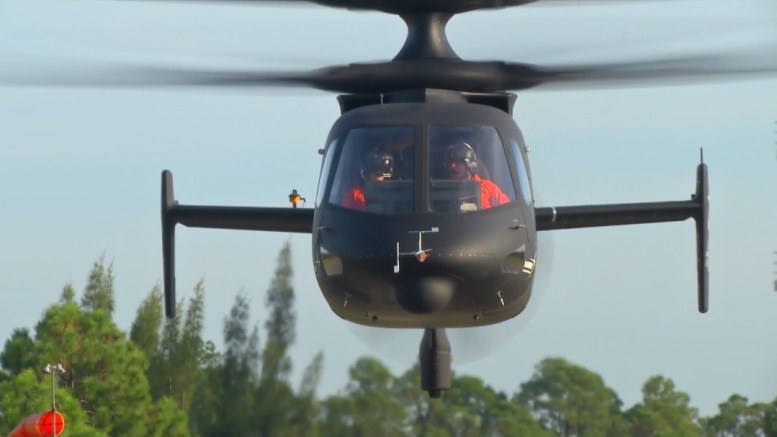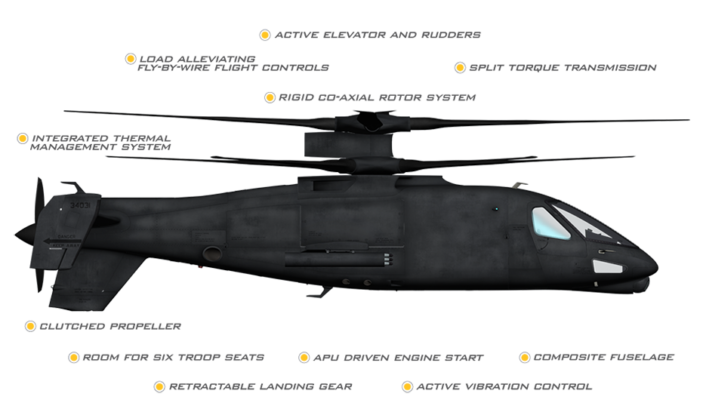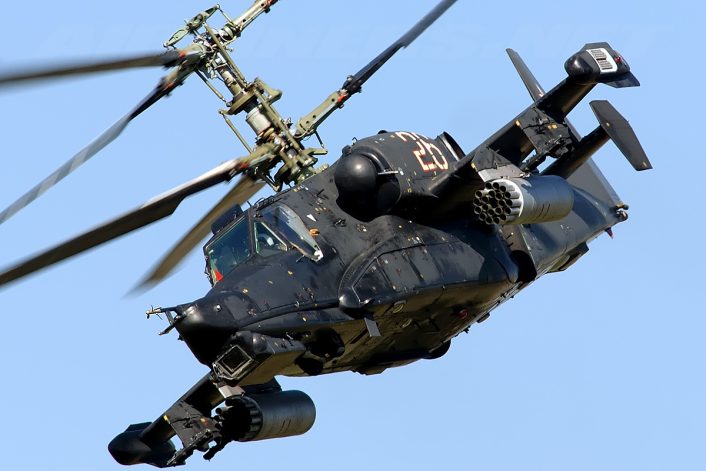
Posted on 04/23/2017 4:58:06 AM PDT by sukhoi-30mki

Proposed Helicopter Would Replace MH-6/AH-6 Little Bird if Adopted.
Lockheed Martin has released a new promotional video showing the S-97 Raider light tactical helicopter demonstrating many of its unique performance capabilities.
The S-97 Raider, if adopted by the U.S. military, would replace the aging family of MH-6/AH-6 Little Bird helicopters widely used since the Vietnam conflict as special operations and observation/light attack helicopters. The MH-6/AH-6 family first flew in 1963 making it a legacy platform that has been continuously updated for expanded roles. Most airframes in U.S. service are now aging and, because a light tactical helicopter is subjected to high stresses in operational and training use the older aircraft are approaching the end of their structural lifespan.
The new S-97 Raider is a significant technology update over previous light attack/observation helicopters. It uses a mostly carbon fiber composite fuselage like the MV-22 Osprey. The S-97 has much higher performance than the MH-6/AH-6 family, more internal space for up to 6 combat equipped troops, a unique co-axial rotor system and a host of additional technological advancements. Lockheed-Martin is firstly and specifically configuring the S-97 as a replacement of the U.S. Special Operations Command MH-6M Little Bird. The significant difference in top speeds between the MH-6M at only 175 MPH and the new S-97 at 276 MPH is just one example of the massive performance and capability improvement available with Lockheed-Martin’s new platform.

Innovative performance features of the new Lockheed-Martin/Sikorsky S-97 Raider. (LM)
Another key performance enhancement is that the S-97 program has greatly improved “hot, high and heavy” rotary wing performance. Helicopters often struggle with performance at high altitude in hot weather conditions and can become vulnerable to performance problems like “vortex ring state”. Vortex ring state likely contributed to the controlled crash of a highly modified U.S. special operations helicopter, the MH-X Stealth Black Hawk, during the May 2, 2011 raid to apprehend Osama bin Laden, Operation Neptune Spear.
Few years ago The Aviationist pointed out some similarities in the possible shape of the MH-X and the S-97.
The new S-97 has already demonstrated stable, controllable hover capability at 6,000 feet AGL and 95° Fahrenheit. The aircraft has also maneuvered at speed to 3g’s.
The co-axial or contra-rotating main rotors on the S-97 were originally conceived by Russian engineer Mikhail Lomonosov. This design has been proven on Russian designs including the successfully deployed newer Kamov KA-50 and KA-52 attack helicopters and much older designs like the KA-27 family of Kamov helicopters widely used in different versions in both military and commercial roles mostly by the Russians.

Contra-rotating main rotors were first developed and employed by the Russians including this Kamov KA-50 attack. (image credit: Russian Aviation Photography)
Advantages to a co-axial rotor system include equalizing the effects of torque compared to helicopters with one-directional large rotating blades or “rotary wings”. Helicopters with a single large rotor system have a tendency to “pull” or rotate in the direction of the main rotor blades’ rotation. To counteract the rotational force of a single main rotor the smaller tail rotor is mounted sideways as is conventionally seen on helicopters. The tail rotor on the new S-97 Raider is rear-facing, adding more thrust than a conventional sideways mounted rotor and contributing to the S-97’s higher top speed.
The S-97 Raider program was initially started to replace the aging OH-58 Kiowa Warrior observation helicopter under a then-$16 billion U.S. Army acquisition program named “Armed Aerial Scout.”
The program was put on hold prior to the U.S. Presidential election due to budgetary constraints. Sikorsky, the originator of the program, teamed with Lockheed-Martin to continue the program and adjusted the marketing focus to a broader mission set.
57% higher top speed. Crikey.
What is the unit cost? The Army pulled the Kiowas and It would be nice to get a good scout bird back in the inventory. We now have to use Apaches for the scout role.
Additionally, Is the SOF a community wanting to replace the Little Birds now, or is this aircraft an expensive solution looking for a problem?
That's "ludicrous speed".
I've seen the marketing video as well as an early training video - hot, hot, hot.
We need this. The Kiowas were stuck in Baghram as they could not fly above peaks with weapons
No kidding. How am I supposed to hang in the door w my boots on the skid? Being inside the aircraft isnt very cool......
RLTW
I’m thinking that I need one of these!
The Kiowa is an excellent example of the mistake of taking an acceptable, civilian platform, and loading it up with armor and armaments and making it a greater danger to its own crew than the enemy.
I was nearly killed in a Kiowa in 1980. Damn you, LBJ! After the OH-6 bested the Bell Jet Ranger in the competition, he ordered Bell to get the contract, anyway. Lady Bird was a major stockholder in Bell Helicopter.
Just like when McNamara gave the jersey award to Ford over Willis. How many soldiers were killed in rollovers of that unstable piece of shit!
Not the jersey award. The contract to replace the M-38 1/4 ton “Jeep”!
Damned spell check!
I spent over 20 years flying army helicopters. Most of my time is in UH-60’s, but I’ve also flown UH-1, OH-58, and AH-1’s. I was in several AVIM and AVUM units as a maintenance test pilot. That got me in a lot of different cockpits.
My observations are simple. I’ll take durable, easy to fix, but maybe a little slow over flashy, complex, fast, but fragile. Aviators want to fly and need many hours in the cockpit to become effective. I didn’t say proficient, I said effective. A chronic lack of flight time plagues the service, in every branch. Commanders are worried about their OR rates more than anything. The best way to have a high OR rate (Operational Readiness) is to limit your flight time.
I know lots of Apache pilots. All have way less actual flight time that UH-60 and OH-58 guys. Barely getting or needed a waver to make your semi-annual minimums sucks.
Not seeing any Armament info. Rockets and 30 Cal I guess.
Not seeing any Armament info. Rockets and 30 Cal I guess.
Good for Lockheed-Martin and good for Sikorsky whom it acquired. Sikorsky would have had a tough go of it, if United Technologies had not found a buyer and instead shoved it out as an independent company. If you are mostly a military contractor, you have to be very large, to sustain you past your production cycles, through R&D into the next contracts. Sikorsky makes some good military helicopters but was to small in the commercial helicopter space to compete with the very much larger competitors in that space. Glad Lockhheed-Martin is making the merger of their talents work.
Great points!
As usual, common sense prevails from hands on folks that KNOW what the heck is REALLY needed!
Quite true. There is a point on the tooth to tail ratio scale when diminishing returns kick in. The more complex the system usually means higher turn around times between flights for aircrews to train/perform. Having extra bells and whistles doesn’t necessarily equate to a better product. Hope this platform design and acquisition process doesn’t follow the same path as the costly and failed Comanche program.
I’m not very familiar with the helicopter industry, but this platform looks like it might have some great adaptations for civilian use as well.
I’d guess the blade configuration would make metro landings safer and the top speed would be an advantage in areas like aerial rescue and patient transport.
Remember that twin-rotored chopper we saw at China Beach?
In a conventional copter with a single main rotor, forward air speed can cause the blade to go supersonic on one side of the AC or stall on the other. This limits top speed to about 1/2 the speed of sound.
With twin rotors you can reduce their rotating speed as forward airspeed increases and still maintain lift on the "trailing" side of the aircraft. If you had enough airspeed, you could even stop the main rotor's rotation altogether and fly it like a fixed-wing biplane (theoretically)
Specs, video, and more at the Lockheed site
http://lockheedmartin.com/us/products/s-97-raider-helicopter.html
I want one. Can you pre-order?
Disclaimer: Opinions posted on Free Republic are those of the individual posters and do not necessarily represent the opinion of Free Republic or its management. All materials posted herein are protected by copyright law and the exemption for fair use of copyrighted works.